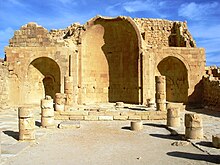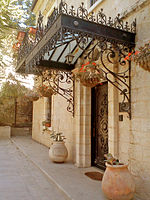This is an old revision of this page, as edited by Jonesey95 (talk | contribs) at 01:30, 16 May 2021 (Fix Linter errors.). The present address (URL) is a permanent link to this revision, which may differ significantly from the current revision.
Revision as of 01:30, 16 May 2021 by Jonesey95 (talk | contribs) (Fix Linter errors.)(diff) ← Previous revision | Latest revision (diff) | Newer revision → (diff)







The architecture of Israel has been influenced by the different styles of architecture brought in by those who have inhabited the country over time, sometimes modified to suit the local climate and landscape. Byzantine churches, Crusader castles, Islamic madrasas, Templer houses, Arab arches and minarets, Russian Orthodox onion domes, International Style modernist buildings, sculptural concrete Brutalist architecture, and glass-sided skyscrapers all are part of the architecture of Israel.
Traditional Arab housing
Further information: Architecture of PalestineUntil the end of the 19th century, the traditional Arab rural house in the villages of what was then Palestine consisted of a single room without partitions, divided into levels in accordance with various functions carried out in the house:
- Rawiyeh – a bottom level at the elevation of the courtyard considered the “dirty” part of the house, used for storage and sheltering livestock.
- Mastabeh – A higher residential level used for sleeping, eating, hospitality and storage.
- Sida (gallery) – Another living area above the mastaba, used primarily for sleeping.
In the second half of the 19th century, a residential story characterized by a cross-vault was added above the traditional house, creating a space between the floor with the livestock in the bottom room and the residential story. A separate entrance was installed in each story.
Fortified houses were built outside the village core and had two stories: a raised ground floor with tiny windows used for raising livestock and storage, and a separate residential floor with large windows and balconies. In the courtyard was a small structure used for storage. Sometimes a tabun baking oven would be located inside it.
The first modern building technology was evident in the farmhouses. Iron beams were used and the roofs were made of concrete and roof tiles. These structures had balconies with a view and wide doorways.
Modern architecture and town planning
Notable architects
Sensing the political changes taking place in central Europe around the time of the First World War, as well as the stirrings of Zionist ideals about the re-establishment of a homeland for Jews, numerous Jewish architects from around Europe emigrated to Palestine during the first three decades of the 20th century. While much innovative planning occurred during the time of the British Mandatory authorities, 1920–1948, in particular the town plan for Tel Aviv in 1925 by Patrick Geddes, it would be architecture designed in the modernist "Bauhaus" style that would fill the plots of that plan; among the architects who emigrated to Palestine at that time, and who went on to establish formidable careers were: Yehuda Magidovitch, Shmuel Mestechkin (1908-2004; specialised in kibbutz architecture), Lucjan Korngold (1897-1963; Poland and Brazil; the Rubinsky House, an early Le Corbusier-style building in Tel Aviv, is often misattributed to him), Jacob (Jacques, Jacov) Ornstein (1886-1953), Salomon Gepstein (1882-1961), Josef Neufeld (1899–1980) and Elsa Gidoni (1899–1978; née Mandelstamm).
Dov Karmi, Zeev Rechter and Arieh Sharon were among the leading architects of the early 1950s. Rudolf (Reuven) Trostler played an important role in designing the country's early industrial buildings. Dora Gad designed the interiors of the Knesset, the Israel Museum, the country's first large hotels, the Jewish National and University Library, El Al planes and Zim passenger ships. Amnon Niv designed Moshe Aviv Tower, Israel's tallest building. David Resnick was a Brazilian-born Israeli architect who won the Israel Prize in architecture and the Rechter Prize for iconic Jerusalem buildings such as the Israel Goldstein Synagogue and Brigham Young University on Mount Scopus.
Movie theaters
The architecture of Tel Aviv's movie theaters can be seen as a reflection of Israeli architectural history: The first cinema, the Eden, opened in 1914, was an example of the eclectic style that was in vogue at the time, combining European and Arab traditions. The Mugrabi cinema, designed in 1930, was built in art deco style. In the late 1930s, the Esther, Chen and Allenby theaters were prime examples of the Bauhaus style. In the 1950s and 1960s, brutalist style architecture was exemplified by the Tamar cinema built inside the historic Solel Boneh building on Allenby Street.
Late Ottoman period
The Templers built homes with tiled roofs like those in the German countryside.
Mandate period
Housing built during the British Mandate was urban in character, with flat roofs, rectangular doorways and painted floor tiles.
Municipal laws in Jerusalem require that all buildings be faced with local Jerusalem stone. The ordinance dates back to the ]British Mandate and the governorship of Sir Ronald Storrs and was part of a master plan for the city drawn up in 1918 by Sir William McLean, then city engineer of Alexandria.
State of Israel, first decades
In the early years of statehood, Israel built rows of concrete tenements to accommodate the masses of new immigrants to replace the huts, tents and packing crates of the maabarot.
From 1948, architecture in Israel was dominated by the need to house masses of new immigrants. The Brutalist concrete style suited Israel's harsh climate and paucity of natural building materials.
Recent developments
First named the "White City" in 1984, the White City of Tel Aviv has been declared a UNESCO World Heritage Site.
As property values have risen, skyscrapers are going up around the country. The Azrieli Sarona Tower in Tel Aviv is the tallest building in Israel to date.
Ephraim Henry Pavie [fr] has evolved from organic architecture towards biomorphism. The Pavie House in Neve Daniel is a rare case of non-geometric, Neo-futuristic blobitecture in Israel.
Museums and archives
A small Bauhaus Museum was established in Tel Aviv in 2008. The Munio Gitai Weinraub Museum of Architecture opened in Haifa in 2012.
Gallery
-
 Old Town Hall, Tel Aviv
Old Town Hall, Tel Aviv
-
 Mugrabi cinema, 1930
Mugrabi cinema, 1930
-
 Yad Kennedy memorial, Jerusalem Forest
Yad Kennedy memorial, Jerusalem Forest
-
 Moshe Aviv Tower, Ramat Gan
Moshe Aviv Tower, Ramat Gan
-
 The Pavie House, 2011
The Pavie House, 2011
-
Meier on Rothschild tower, in 2013 Tel Aviv's highest residential building
"Architecture of Israel" magazine
| It has been suggested that this section be split into a new article titled Architecture of Israel (journal). (discuss) (February 2021) |
Architecture of Israel (AI) is a Hebrew & English bilingual quarterly dealing with architecture, interior design and the environment. Published since January 1988, the aims of the journal, as stated on its website air.co.il: are to "promote climate and environmental awareness, creative and feasible architecture". AI provides a stage for Israeli architecture in an international context and conducts each year an international competition together with the European Union, titled "Project of the Year". The judges are worldwide known academics and architects. Permanent sections:
- "Food for Thought", deals with how other fields of life impact architecture
- "Curiosity", covering events, competitions and exhibitions
- Interviews with Israeli and international architects
- "House of the Season", presents a different perspective on the residential issue
- "Guest of the Season", the professional profile of a selected architect
- "Architects Telling", behind-the-scenes stories about well-known buildings
See also
- Architecture of Palestine, which overlaps in countless regards with the architecture of Israel and vice versa
- List of Jewish architects
References
- ^ Heritage Conservation in Israel
- Shmuel Mestechkin at GreyScape. Accessed 10 May 2021.
- Lucjan Korngold at GreyScape. Accessed 10 May 2021.
- Anna Cymer, Lucjan Korngold at culture.pl. Accessed 10 May 2021.
- The Rubinsky House, Amnon Bar Or – Tal Gazit Architects Ltd. Accessed 10 May 2021.
- Elsa Mandelstamm Gidoni at Pioneering Women of American Architecture. Accessed 10 May 2021.
- ^ A Concrete Life, Noam Dvir, Haaretz Magazine, October 17, 2008
- Dora Gad's private sanctuary
- Encyclopedia Judaica, 2008, as quoted by Jewish Virtual Library, retrieved September 13, 2012
- Brittain-Catlin, Timothy, "Israel Goldstein Synagogue, Givat Ram campus of the Hebrew University, Jerusalem, Israel Heinz Rau and David Reznik", Building of the Month, Twentieth Century Society, June 2010, retrieved September 13, 2012
- Dvir, Noam, "A mixed modernist message," Haaretz, February 2, 2012, retrieved September 13, 2012
- Architectural milestones
- PAUL GOLDBERGERPublished: September 10, 1995 (1995-09-10). "Passion Set in Stone, New York Times, Sept. 10, 1995". New York Times. Retrieved 2012-08-28.
{{cite web}}: CS1 maint: numeric names: authors list (link) - "Jerusalem Architecture Since 1948". Jewishvirtuallibrary.org. Retrieved 2012-08-28.
- The British Mandate from "Jerusalem: Life Throughout the Ages in a Holy City". Online course material from the Ingeborg Rennert Center for Jerusalem Studies, Bar-Ilan University, Ramat-Gan, Israel
- Encyclopedia of Zionism and Israel, edited by Raphael Patai, Herzl Press, McGraw, New York, 1971 "Architecture and Town Planning in Israel," Vol. 1, pp. 71-76
- Sir Banister Fletcher's A History of Architecture
- "Futuristic House Biomorphism by Ephraim Henry Pavie Architects and Design". Tuvie. 11 July 2011. Retrieved 10 May 2021.
- Kanti, Yonatan (2 April 2012). השראה למכירה: המקרה המוזר של הבית בגוש עציון [Inspiration for sale: The curious case of the house in Gush Etzion]. Nrg Maariv (in Hebrew). Retrieved 10 May 2021.
- Hecht, Esther. "Bauhaus Museum Opens in Tel Aviv's White City". Architectural Record. Retrieved 5 September 2012.
- Amos Gitai sets up Israel's first architecture museum in memory of his father, Haaretz
- "the 2020 competition" (https://www.aiq.co.il/reg_competition.php). Retrieved 2020-07-25.
- Issue no. 108. Retrieved 2020-07-25.
- "Tigran in KHT webpage" (https://www.kth.se/profile/Tigran). Retrieved 2020-07-25.
- "Oxman's personal site" (http://rivkaoxman.wix.com/rivkaoxman#!/). Retrieved 2020-07-25.
| This article may require cleanup to meet Misplaced Pages's quality standards. The specific problem is: These references need to be moved inline. Please help improve this article if you can. (February 2021) (Learn how and when to remove this message) |
- 6. "Turkienicz's webpage at the university" (https://www.researchgate.net/profile/Benamy_Turkienicz2). Retrieved 2020-07-25.
- 7. "Carmon's professional details" (https://muchanut.haifa.ac.il/index.php/en/about-eng/first-row/researchers/item/18-carmon-naomi). Retrieved 2020-07-25.
- 8. "Stav's business webpage" (https://www.osvaldo-stav.com/about-us). Retrieved 2020-07-25.
- 9. "Meir's webpage at the university" (https://in.bgu.ac.il/en/engn/struct/pages/staff/Sakis.aspx). Retrieved 2020-07-25.
- 10. "Grobman's webpage at the institute" (https://grobman.net.technion.ac.il/). Retrieved 2020-07-25.
External links
- JewishVirtualLibrary.org: Archaeology
- Arzaworld.com: Historical Architecture and Design in Israel
- A little modesty goes a long way by David Kroyanker
- Fifty Years of Israeli Architecture as Reflected in Jerusalem's Buildings, Israel Ministry of Foreign Affairs, 26 May 1999
- Israel Architect Design
- Architecture of Israel Quarterly
- "Jerusalem: Architecture in the late Ottoman Period" by Lili Eylon